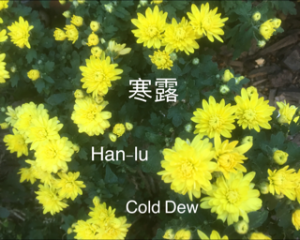
Han-lu (noun) 寒露 (Chinese): Cold Dew (17th solar term), literally in Chinese “Han” 寒 = cold, “lu” 露 = dew.
Example:
Han-lu is the 17th solar term of the 24 solar terms in the Chinese lunar calendar. Han-lu begins when the Sun reaches the celestial longitude of 195° and ends when it reaches the longitude of 210°. Han-lu often refers in particular to the day when the Sun is exactly at the celestial longitude of 195°. In the Gregorian calendar, Han-lu usually begins around October 8 and ends around October 23. During Han-lu, the temperatures are much lower than in Bai-lu (White Dew) in most areas of China. The dew is greater and colder and there will be less rain. In China, Han-lu is used as a symbol of the weather turning from cool to cold. In Han-lu the dew exposed to cold will be condensed into frost. So keep your feet warm after Han-lu.
Believe it or not, the Chinese proverb says; there are three periods in Han-lu. In the first period of Han-lu 鸿雁来宾, most wild geese flying south pass through as quests. During the second period 雀入水为蛤, people think that little birds dive into the sea becoming “clams”. During the last five days of Han-lu 菊始黄华, the chrysanthemum is the only yellow flower blooming in late autumn.
Natural flowers, trees, birds, and animals all live and move according to a certain season. Their activities are closely related to climate change. Each period 候 in a Jie-qi 节气 is associated with a flower letter breeze 花信风. During Han-lu, the first period is associated with Oleander 夾竹桃, the second period with Cockscomb 鸡冠花, and the third period with Canna 美人蕉. In addition to these three flowers, there are other flowers such as the chrysanthemums that still bloom in the Cold Dew (Han-lu).
Since ancient times, Han-lu has been a solar term for agricultural purposes in the lunar calendar. Han-lu is still remembered and celebrated as a Chinese traditional festival.
